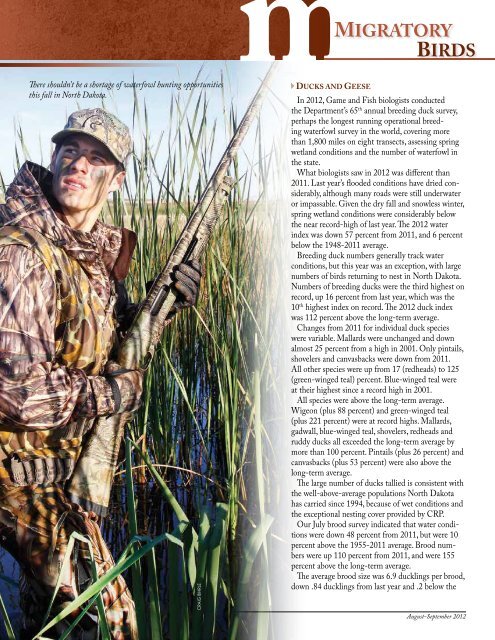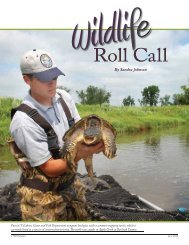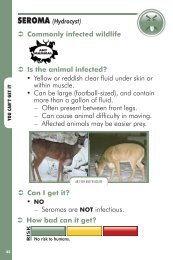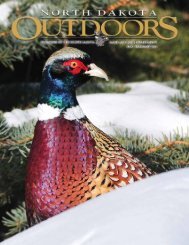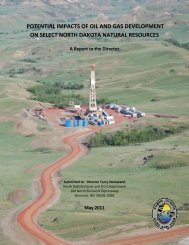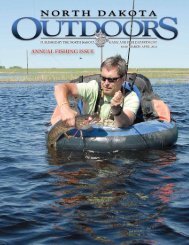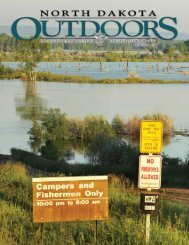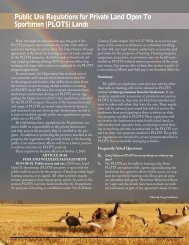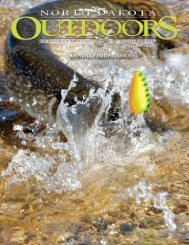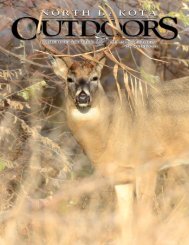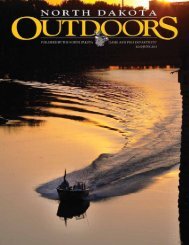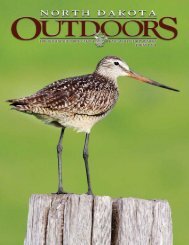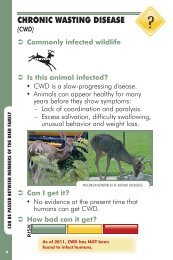North Dakota Outdoors Magazine August-September 2012 ...
North Dakota Outdoors Magazine August-September 2012 ...
North Dakota Outdoors Magazine August-September 2012 ...
- No tags were found...
You also want an ePaper? Increase the reach of your titles
YUMPU automatically turns print PDFs into web optimized ePapers that Google loves.
MIGRATORYBIRDSThere shouldn’t be a shortage of waterfowl hunting opportunitiesthis fall in <strong>North</strong> <strong>Dakota</strong>.CRAIG BIHRLE DUCKS AND GEESEIn <strong>2012</strong>, Game and Fish biologists conductedthe Department’s 65 th annual breeding duck survey,perhaps the longest running operational breedingwaterfowl survey in the world, covering morethan 1,800 miles on eight transects, assessing springwetland conditions and the number of waterfowl inthe state.What biologists saw in <strong>2012</strong> was different than2011. Last year’s flooded conditions have dried considerably,although many roads were still underwateror impassable. Given the dry fall and snowless winter,spring wetland conditions were considerably belowthe near record-high of last year. The <strong>2012</strong> waterindex was down 57 percent from 2011, and 6 percentbelow the 1948-2011 average.Breeding duck numbers generally track waterconditions, but this year was an exception, with largenumbers of birds returning to nest in <strong>North</strong> <strong>Dakota</strong>.Numbers of breeding ducks were the third highest onrecord, up 16 percent from last year, which was the10 th highest index on record. The <strong>2012</strong> duck indexwas 112 percent above the long-term average.Changes from 2011 for individual duck specieswere variable. Mallards were unchanged and downalmost 25 percent from a high in 2001. Only pintails,shovelers and canvasbacks were down from 2011.All other species were up from 17 (redheads) to 125(green-winged teal) percent. Blue-winged teal wereat their highest since a record high in 2001.All species were above the long-term average.Wigeon (plus 88 percent) and green-winged teal(plus 221 percent) were at record highs. Mallards,gadwall, blue-winged teal, shovelers, redheads andruddy ducks all exceeded the long-term average bymore than 100 percent. Pintails (plus 26 percent) andcanvasbacks (plus 53 percent) were also above thelong-term average.The large number of ducks tallied is consistent withthe well-above-average populations <strong>North</strong> <strong>Dakota</strong>has carried since 1994, because of wet conditions andthe exceptional nesting cover provided by CRP.Our July brood survey indicated that water conditionswere down 48 percent from 2011, but were 10percent above the 1955-2011 average. Brood numberswere up 110 percent from 2011, and were 155percent above the long-term average.The average brood size was 6.9 ducklings per brood,down .84 ducklings from last year and .2 below the12 ND <strong>Outdoors</strong> <strong>August</strong>-<strong>September</strong> <strong>2012</strong>


